Skunks
Skunks were a continuing source of complaint for the settlers in this region. And the saga continues: there are frustrated letters to the editor about skunks to this day. (Yet, when I set out to take some skunk pictures, they were not all that easy to find).
Nuisance skunks? Public pressure prompted the Nelson City Council to treat skunks as a nuisance and to ship them elsewhere (which doesn’t amuse the folks from elsewhere). But are skunks the problem? What about dogs? A dog is perhaps the only animal so untutored as to tackle a skunk. This probably doesn’t reflect inherent canine stupidity, but ignorance: pups weren’t taught skunk avoidance by their mothers (a consequence of our own dog–rearing tactics). Skunks are actually reluctant to fire, and will only do so if persistently challenged. But untutored dogs do challenge skunks. Alas in Nelson, the skunk is demonized for the ineptitude of pets—not to mention, owners. Ironically, skunks benefit gardens by eliminating all manner of pests.
The skunk is perhaps one of the most widely recognized (and respected) wild animals. This timid, clumsy, slow-moving, cat-sized animal might appear to be an easy mark for a wide range of hungry predators. And it would be if it weren’t for butylmercaptan—a noxious liquid the skunk can spray up to six meters. As a consequence, about the only predator willing to tackle a skunk is the Great Horned Owl—presumably owing to the owl’s marginal sense of smell.
The only species of skunk found around the Lake is the Striped Skunk, readily recognized by having two white stripes extending from the neck to tail, and a single white stripe between the nose and forehead. The skunk is omnivorous, eating everything a wide variety of insects, bird eggs, amphibians, reptiles, small mammals, but also grains, and fruits. It seems to consider municipal areas to be a good source of easy pickings and so is seen more often in the back yards of Nelson than in the more rural areas along the lakeshore. But, it is along the lakeshore also.
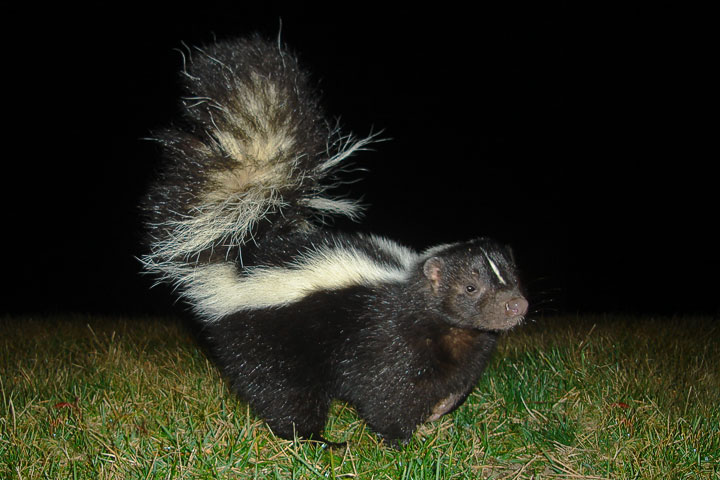 The Striped Skunk is a nocturnal animal—this picture was taken at 3am. I have occasionally seen it in the evening, but rarely. Usually when a skunk forages, it has its nose to the ground; it is less common to get a picture such as this with the skunk’s head raised.
The Striped Skunk is a nocturnal animal—this picture was taken at 3am. I have occasionally seen it in the evening, but rarely. Usually when a skunk forages, it has its nose to the ground; it is less common to get a picture such as this with the skunk’s head raised.
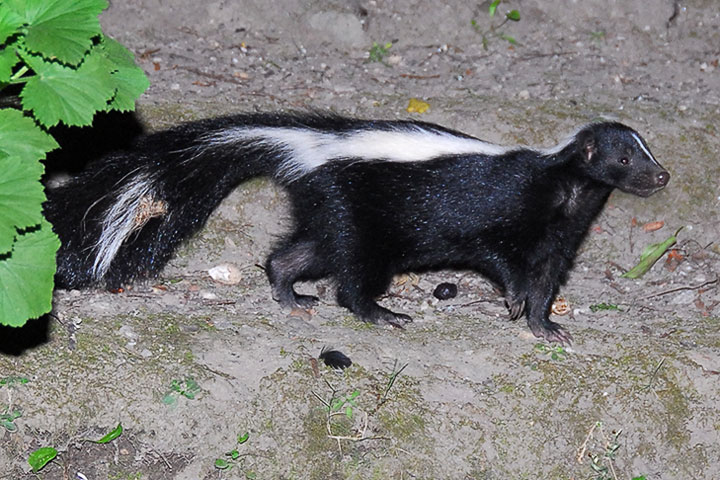 This Skunk heads out in the evening to forage for food in a Nelson garden.
This Skunk heads out in the evening to forage for food in a Nelson garden.
 The Striped Skunk is well marked by two white stripes along it’s back and tail and a single one on its face. Predators are never under any doubt as to the animal they face. This skunk is foraging in the evening in a Nelson garden.
The Striped Skunk is well marked by two white stripes along it’s back and tail and a single one on its face. Predators are never under any doubt as to the animal they face. This skunk is foraging in the evening in a Nelson garden.
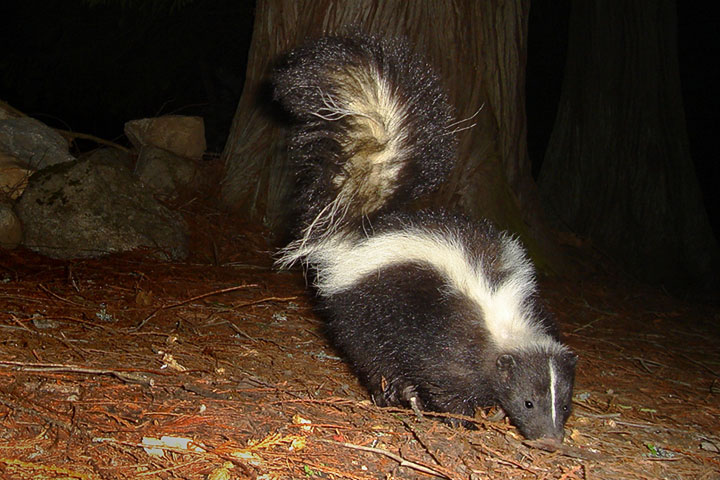 As it forages at night on the forest floor, a skunk follows its nose.
As it forages at night on the forest floor, a skunk follows its nose.
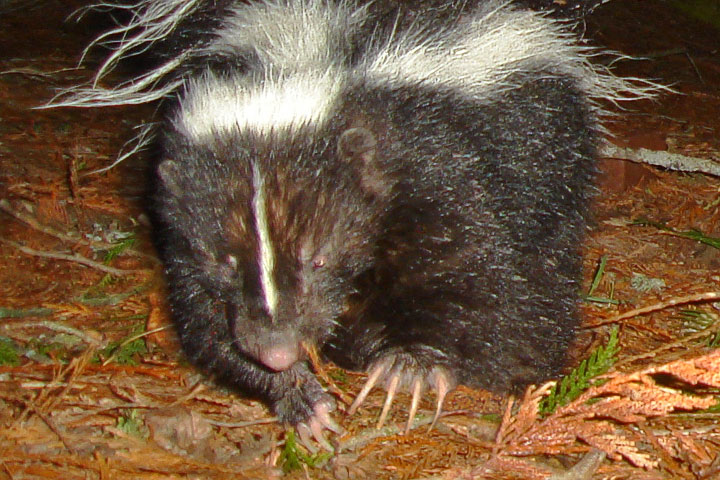 The skunk digs with the long claws on its forepaws.
The skunk digs with the long claws on its forepaws.
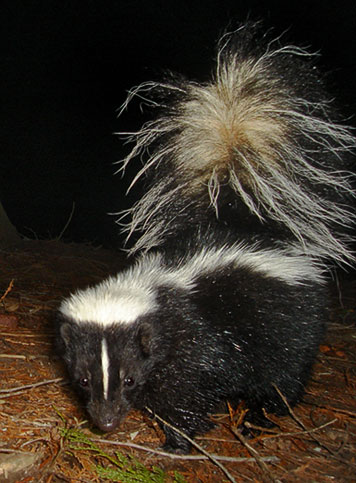 Skunk portrait—usually the skunk has its nose to the ground when it is foraging.
Skunk portrait—usually the skunk has its nose to the ground when it is foraging.
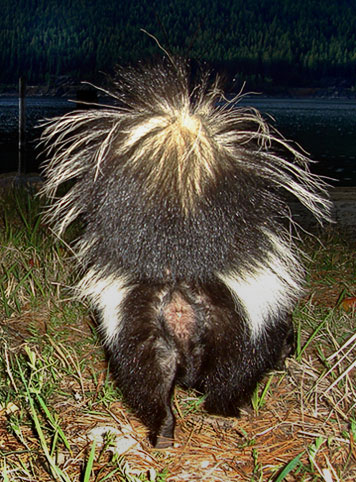 This is the view you don’t want when the skunk is angry. A scent gland sits to either side of the anus.
This is the view you don’t want when the skunk is angry. A scent gland sits to either side of the anus.
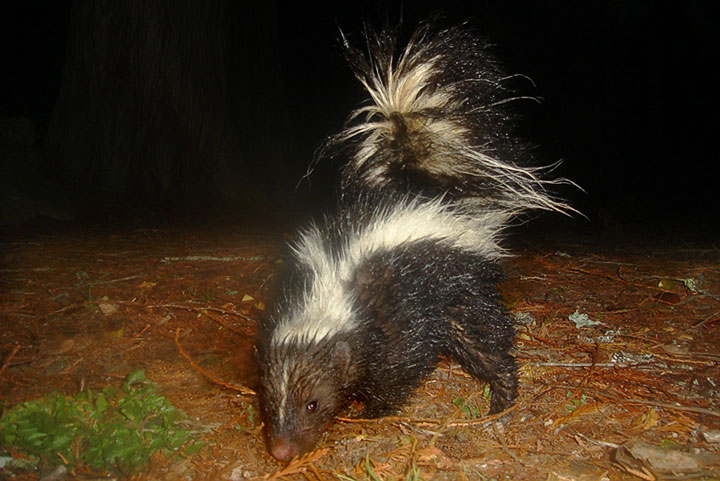 Skunks that forage in the woods all seem to do so with their tails up. As with their distinctive colouring, the raised tail is likely a device to make them as noticeable as possible—a warning to all predators.
Skunks that forage in the woods all seem to do so with their tails up. As with their distinctive colouring, the raised tail is likely a device to make them as noticeable as possible—a warning to all predators.
 Skunk art: in the black of night, a passing skunk presents an striking and chaotic design.
Skunk art: in the black of night, a passing skunk presents an striking and chaotic design.
![]()